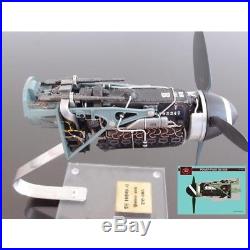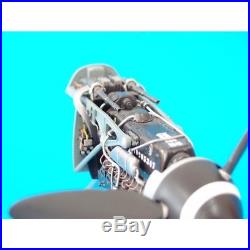1/18 Power Unit Engine Messerschmitt Bf109G-6 (Daimler Benz Db605) Resin Kit JPH





1/18 Power Unit Engine Messerschmitt Bf109G-6 (Daimler Benz Db605) Resin Kit. 1:18 Scale resin model kit Power Unit Engine Messerschmitt BF109G-6 (Daimler Benz DB605). This is a Resin Kit recommended & only for Experienced Model Builders. Primary parts and details made of resin. Building instructions printed and on a CD.
This is a Limited Edition Resin Model Kit. It Does not Include the metal Stand and Base.
Some Information on a Real DB 601 Engine. From Wikipedia, the free encyclopedia. ApplicationsUp to 1,100 PS (809.0 kW; 1,085.0 hp) at sea-level with 2,400 rpm, up to 1,020 PS (750.2 kW; 1,006.0 hp) at 2,400 rpm and 4,500 m (14,800 ft) altitude, B4 fuel.
Up to 1,175 PS (864.2 kW; 1,158.9 hp) at sea-level with 2,500 rpm, up to 1,100 PS (809.0 kW; 1,085.0 hp) at 2,400 rpm and 3,700 m (12,100 ft) altitude, B4 fuel. Same as DB601 A-1 for use in Messerschmitt Bf 110 and/or bomber aircraft (different prop/engine ratio, 1:1.88 instead of 1:1.55). Similar to Aa for use in Messerschmitt Bf 110 and/or bomber aircraft (different prop/engine ratio, 1:1.88 instead of 1:1.55). For use in the Heinkel He 100D 1,175 PS (864.2 kW; 1,158.9 hp). Up to 1,175 PS (864.2 kW; 1,158.9 hp) at sea-level and at 4,900 m (16,100 ft) altitude with 2,600 rpm, C3 fuel.
Up to 1,270 PS (934.1 kW; 1,252.6 hp) at 2,100 m (6,900 ft) altitude with 2,600 rpm. Same as DB 601 N for use in Messerschmitt Bf 110 and/or bomber aircraft (different prop/engine ratio, 1:1.88 instead of 1:1.55). Up to 1,350 PS (992.9 kW; 1,331.5 hp) at sea-level with 2,700 rpm, up to 1,320 PS (970.9 kW; 1,301.9 hp) with 2.700 rpm at 4,800 m (15,700 ft) altitude, B4 fuel. Up to 1,450 PS (1,066.5 kW; 1,430.2 hp) at 2,100 m (6,900 ft) altitude with 2,700 rpm. Same as DB 601 E for use in Messerschmitt Bf 110, Messerschmitt Me 210 and/or bomber aircraft different prop/engine ratio, 1:1.875 (601F), 1:2.06 (601G) instead of 1:1.685.
Two DB 601 F or G coupled to work on a single propeller shaft for use in early Heinkel He 177As - 2,700 PS (1,986 kW) at sea level with a mirror-imaged starboard component engine supercharger, and derided as "welded-together engines" by ReichsmarschallHermann Göring in August 1942, from the problems they caused with engine fires in the He 177A during service from their inadequate installation design; such problems were not present in either the Heinkel He 119 and Messerschmitt Me 261 which also used them. Licence built by Alfa Romeo in Italy. Alfa Romeo RA 1000 RC 41. Type: Twelve-cylinder liquid-cooled supercharged 60° inverted Vee aircraft piston engine. Bore: 150 mm (5.91 in). Stroke: 160 mm (6.30 in). Displacement: 33.93 l (2,070.54 cu in). Length: 1,722 mm (67.80 in).Dry weight: 590 kg (1,300 lb). Valvetrain: Two intake and two sodium-cooled exhaust valves per cylinder actuated via a single overhead camshaft per cylinder block. Supercharger: Gear-driven single-speed centrifugal type supercharger (later, hydraulic-driven[4]).
Fuel system: Direct fuel injection. Oil system: Dry sump with one pressure and two scavenge pumps. 1,175 PS (864.2 kW; 1,158.9 hp) at 2,500 rpm for takeoff. 1,070 PS (787.0 kW; 1,055.4 hp) at 2,400 rpm at 3,700 m (12,100 ft).
Specific power: 25.52 kW/l (0.56 hp/in³). Compression ratio: 6.9:1. Specific fuel consumption: 270 g/(kW·h) 0.44 lb/(hp·h). Power-to-weight ratio: 1.47 kW/kg (0.89 hp/lb). Its a cottage industry compared to the big brands.This is because Companies that make Resin Kits usually concentrate on subjects not made by the main model companies. Resin Kits often contain extra detail like Metal Etch Parts and sometimes metal Undercarriage.
So if you want something different go for a Resin Model. As building resin kits is seen to be a "Black Art" by some modellers, we offer the following advice guide: From CMR. 1 - Study the instructions and familiarise yourself with the parts before starting to work in a methodical manner, as resin kits do not have individual part numbers. 2 - Wash the parts thoroughly with detergent before any assembly or painting. This is to remove mould release agent left over from the manufacturing process.
3 - Carefully remove the parts from the pouring blocks using a razor saw - or scalpel for small items - and clean them up before starting construction. Resin can be sanded easily and scribed like styrene to restore over-sanded panel lines, although scribing is best accomplished with a very sharp scriber and light strokes. Note: a certain amount of "Flash" is normal on resin kits due to the manufacturing processes involved, but this is easily removed.
4 - Test-fit everything to check for a decent fit before committing to glue. Some shrinkage is normal for resin parts due to the batch variances in resin used and temperature. 5 - Warped parts are not that unusual in resin kits and can easily be corrected by gently heating the part with a hairdryer or by running it under a lukewarm tap before easing it back into shape.6 - Use 5-minute Epoxy for large joins. Cyanoacrylate adhesive is more suitable for smaller joins. 7 - Gaps can be filled using "Superglue" Gel such as Pro-Bond No.
3 Slow Set/Gap Filling cyanoacrylate or normal model filler (such as Milliput epoxy putty). When using normal model filler it is possible to use a cotton bud lightly coated in Acetone (nail varnish remover) or Cellulose thinners to clean up the join as, unlike polystyrene, resin does not melt when in contact with cellulose thinners. 8 - Use a resin primer such as Mr. Resin Primer Surfacer" (by Gunze Sangyo) as this will reveal any "Pinholes left by air bubbles as a result of the manufacturing process - it also provides a key for the final paint finish to adhere to. 9 - Pinholes can be filled using drops of primer, superglue or even correction fluid (such as Tippex). 11 - Resin kits can be painted with normal model paints i. Enamel or Acrylic paints such as: Gunze Sangyo, Humbrol, Model Master, Revell, Tamiya, etc. 12 - Vac-form canopies are normally supplied in pairs.Glues (such as Krystal Klear) are best for affixing to the model - applied by small brush; any excess can be removed with a damp cloth before it has cured. However by first dipping the canopies in Johnson's "Future", not only does this improve the transparency of the canopy material, but it also prevents Cyanoacrylate (Superglue) from fogging them. Note: Cyanoacrylatesshould not be used directly on untreated acetate canopies, as a white'blooming' may occur due to the adhesive reacting on contact with the transparency material. 13 - Decals supplied with our models do not require the use of solvents during their application.
14 - Many of our newer models now include Photo-Etch Detailing Sets. PE parts are best glued with cyanoacrylate (superglue). We pay more for good Couriers.
Our Main EMS Parcel Couriers are AnPost and Fastway. The item "1/18 Power Unit Engine Messerschmitt Bf109G-6 (Daimler Benz Db605) Resin Kit JPH" is in sale since Friday, January 06, 2017. This item is in the category "Toys & Games\Model Kits\Models". The seller is "jhmcloughlin" and is located in Newbridge. This item can be shipped worldwide.- MPN: JPHPHKS18101R
- Brand: HPH Models
